Keywords
Exercise; Management; Emergency medicine
Introduction
The triage is the most important and essential part of the MCI medical management to sort and evaluate the victims to different categories in a disaster. Triage facilitates in prioritizing who need different transport, evacuation and treatment at the field as well as at hospital. Triage is derived from the French trier, meaning ‘to sort or sieve’ [1]. Triage includes different forms and operations at several different levels. The primary aim is to give the right patient the right care at the right time in the right place. It also means ‘doing the best for the most all the time with the available resources [1].
The triage is originally developed for military use and equally applicable to civilian disasters and day-to-day emergency settings. Accurate triage allows correct identification of those patients who need the most urgent intervention and transport to hospital and those who can wait longer for treatment and those who are so severely injured and will not survive so only palliative care given [2].
The medical and paramedical persons perform triage in MCI situation according to site and guidelines of the health system by using different tools and systems like SORTE, SALT [3] SIEVE [4] and START. This study uses START system for a written paper based and tabletop exercise which uses physiological parameters as well as walking and obeying command abilities. This triaging process facilitates rapid sorting, transporting and treating of casualties at field as well as hospital level (Figure 1).
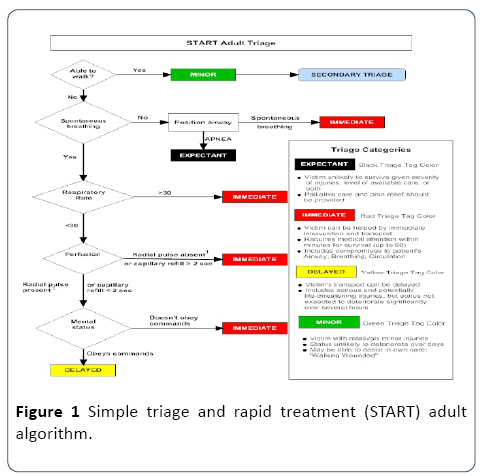
Figure 1: Simple triage and rapid treatment (START) adult algorithm.
The MCI triage is dynamic, reproducible and repeatable process. Therefore, we have primary, secondary and tertiary triage at different sites as well as reversed triage for making a surge capacity for health facility during disaster management.
The goal is to do most for the most and triage a correct patient at correct time to correct facility by correct transport method. The victims are categorized to different priorities like:
T1 or P1 immediate or red, T2 or P2 delayed or yellow T3 or P3 minimal or green T4 or p4 expectant or blue.
The different visual color codes to organize and simplify the triaging process. Consequently, the triage process is seen in a wider context and is composed of the many elements.
They include:
1. Rapid evaluation of all disaster victims.
2. Assessment of the nature and severity of the injuries and its consequences on the vital functions of the casualties.
3. Categorization of the casualties.
4. Stabilization and conditioning for transport.
5. Distribution and evacuation of the casualties.
6. Admission to healthcare facilities for definitive care [1].
Triage priorities and levels
The triage priority schemes vary across the world and within countries also. Some countries use the treatment (T) system, while others use the priority (P) system. The notable difference between the P and T systems is the use of the expectant category. The both systems are commonly used in conjunction with color coding. MCI triage also causes ethical considerations and legal responsibilities. Therefore, there are certain parameters that govern and measure the triaging process like accuracy which measures over and under triage, reliability and validity which are reproducibility and ability to achieve objective on other hand. MCI triage skills and knowledge are very essential for medical staff dealing with MCI management especially for those on front line like EMS services and emergency department staff.
This study simply divided the ED staff randomly into two group intervention and control groups. The intervention group used table top exercise (TTX) for 60 minutes using START triage for triaging 20 standardized cases before and after TTX to evaluate the effectiveness and improvement in triaging skill of the ED staff by this technique.
The control group has gone through standard ordinary way of written paper based instructions about START triage and triaging 20 standardized cases same case used for intervention group. The control group session proceeded by pre-test and followed by same case for the post-test to evaluate the effectiveness and improvement.
Objectives
To evaluate the effectiveness of tabletop exercise on emergency department staff triaging skills improvement in comparison to the written paper based instructions about START triage and it application on disaster cases according to their different triage category.
So the primary outcome measure was to evaluate the effectiveness of tabletop exercise (TTX) on triaging skills improvement of emergency department staff in comparison to the written paper based instructions by using START triage system for triaging 20 standardized MCI cases.
These techniques were applied on ED staff in emergency department to improve their triaging skills for mass casualty incident triage management.
Literature Review
The study has conducted an extensive literature review on the subject and searched a lot of disaster websites and related studies, the founded studies mostly compare triage system to other system or tool to other tool like SIEVE triage in comparison to START triage at field [5]. The comparison also includes simulations on different triage systems as well as virtual reality triage training [6]. There are very few studies which evaluated the different methods to improve the triaging skill of the staff. There are different methods to teach the MCI providers including one new well known called Emergo train system.
Therefore, this study planned to do tabletop exercise by using START triage system and see the effectiveness of this (TTX) method on improving ED staff skills in comparison to ordinary methods like written paper based instructions or lectures on START triage [7].
Research Methodology
Study design and protocol
This study is simple randomized controlled trial (RCT); it conducted from 20 Augustus 2016 till 28 February 2017 in the Hamad general hospital emergency department (HGH ED). The study population was randomly and equally divided into two groups as intervention and control group. The intervention group went through table top exercise for 60 minutes and their pre-and post MCI triage knowledge and skills are evaluated by pre and post-tests by 20 standardized START triage cases.
The control group went through written paper based instructions and scenario of 20 START standardized triage cases used for pre and post reading tests. They are evaluated by the same triage cases which are used for the intervention group.
Study setting and flow
RCT is the best experimental method to evaluate two groups or drugs or methods scientifically. The ED medical and nursing staffs are randomly divided into two groups, intervention and control groups.
The group A is the intervention group and given tabletop exercise for 60 minutes based on MCI scenario of 20 standardized cases which are evaluated and triaged according to START triage system.
A pre-test done for intervention group followed by table top exercise (TTX) and post- tests consisted of the same START triage cases to evaluate the effectiveness of intervention (TTX) and the results before and after intervention (Table 1).
Table 1 Results before and after intervention.
| Intervention group |
| |
Pre-test |
Post test |
| Total triage cases |
20 |
20 |
| Correct triage |
15 |
19 |
| Over triage |
15% |
5% |
| Under triage |
10% |
5% |
The control group, given written introduction of START triage and 20 scenario of standardized cases which are triaged according to START triage system to examine and evaluate their basic skills with pre-reading and post reading tests without TTX (Table 2).
Table 2 Pre-reading and post reading tests without TTX.
| Control group |
| |
Pre-reading |
Post-reading |
| Total triage cases |
20 |
20 |
| Correct triage |
10 |
14 |
| Over triage |
40% |
20% |
| Under triage |
10% |
10% |
The study conducted multiple sessions of tabletop exercises and pre and post-tests over five months periods from 20 August 2016 till February 2017 in one or twice month based fashion in HGH ED.
Each session has involved about 30 Emergency Department (ED) medical and nursing staff in each intervention and control group in each round.
Comparative results of the both intervention and control groups (Table 3).
Table 3 Results of intervention and control groups.
| Comparison |
| |
Intervention |
Control |
| Total triage cases |
20 |
20 |
| Correct triage |
19(90%) |
14(70%) |
| Over triage |
5% |
20% |
| Under triage |
5% |
10% |
| Time to triage all 20cases (In minutes) |
5.4 minutes |
8.2minutes |
Inclusion and exclusion criteria
All ED medical staff doctors and nurses are included in the study who given a consent and voluntary agreement to participate in this study. They were also given option to withdraw whenever they like. The study included 106 persons each group have 53 persons, as 53 in intervention group and 53 persons in control group. They are assigned to each group randomly as the Table 1 shows the characteristic of the study population and similarity of both groups. The study excluded 6 persons from medical and nursing staff, as they were unwilling to give consent for the participation. So the study has a total population of 100 medical and nursing staff in this study after exclusion of 6 staff due to consent issues as shown below in the flow chart (Figure 2).
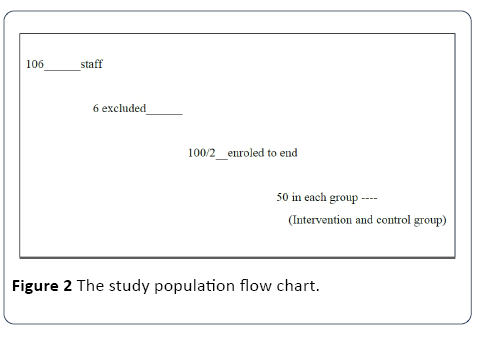
Figure 2: The study population flow chart.
Ethical approval and funding
The ethical approval was taken from the ethical committee of the emergency department and hospital ethical committee at Hamad general hospital at Doha Qatar. The committees revised the process of consent of the ED staff and study method. The study was funded by Hamad medical corporation (HMC HGH ED) Doha Qatar.
Sampling method and validity
The sample size estimated and calculated according to the statistical procedure. The study sample was 106 persons in total which consisting of 52 doctors and 54 nurses in both control and intervention groups selected randomly from Hamad General Hospital Emergency Department (HGH ED) staff. The 2 doctors and 4 nurses withdraw from the study before start of the trials. The distribution was near equal for both doctors and nurses in each intervention and control group as shown below in Table 4.
Table 4 Characteristic of the study population.
| |
Intervention group |
Control group |
| Age |
mean 37-45 y |
mean 37-45 y |
| Sex |
M/F 27/23 |
M/F 29/21 |
| ED experience |
>5 Years 90% |
>5 Years 87% |
| MIMMS course |
13 People |
11 People |
| Past MCI drills Done |
15 Staff |
13 Staff |
| Worked in real MCI |
8 Staff |
5 Staff |
| Doctors |
22 |
24 |
| Nurses |
28 |
26 |
| Number of cases to triage |
20 |
20 |
| START triage used |
yes |
yes |
M=male, F=female, MIMMS =Major incident medical management support course (UK)
Data Collection and Data Analysis
Data collected manually and electronically, checked, corrected, recorded, stored and entered into computer for further analysis after involvement of expert statistician.
The statistical tests are used as T-test and Chi-Square. The frequency distribution and percentage is also presented in the descriptive format.
Results
The study results report 90% triage accuracy in the intervention group and 70% in control group with a difference of 20% to 30%. The time to triage for 20 standardized cases was 5.4 minutes in intervention group and 8.2 minutes in control group as participants in the intervention group triaged their patients more quickly than participants in the control group mean difference 2.8 minutes 98.5% confident interval 5.4 to 8.2 minutes. The over and under triaging were 5% for both in the intervention side but 20%, 10% respectively in the control side. The reliability was also found better at intervention side due to repeated training. The validity is not measured because the nature of work is simulation and only one triage system is used.
To explain more the intervention group (tabletop exercise TTX) triage accuracy was 90% as they triaged 19 cases correctly out of 20 cases in 5.4 minutes. The control group was 70% accurate as they triaged 14 cases correctly out of 20 cases in 8.2 minutes. The tabletop group is more accurate and efficient than the control group according to the data (Figures 3 and 4).
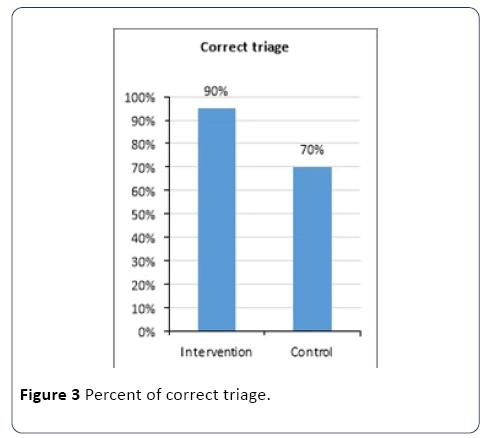
Figure 3: Percent of correct triage.
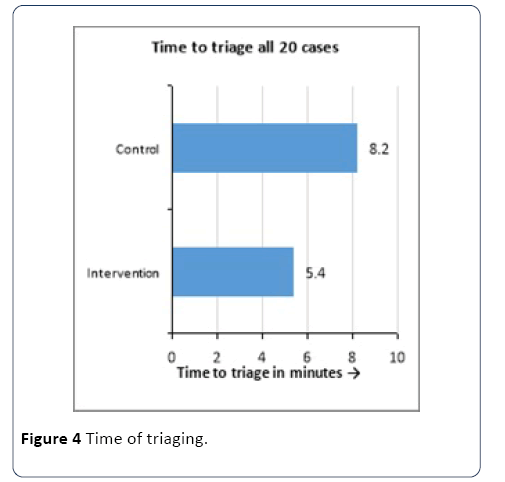
Figure 4: Time of triaging.
The study also measured two important errors of triage accuracy which are over and under triage, which means triaging non-critical patient as critical one, and critical patient as non-critical one respectively. This can lead to adverse consequences or death due to transport and treatment delay [1].
The over triage and under triaging for intervention group were about 5% and 5% respectively and the control group over and under triaging were 20% and 10% respectively (Figures 5 and 6).

Figure 5: It shows over triage.
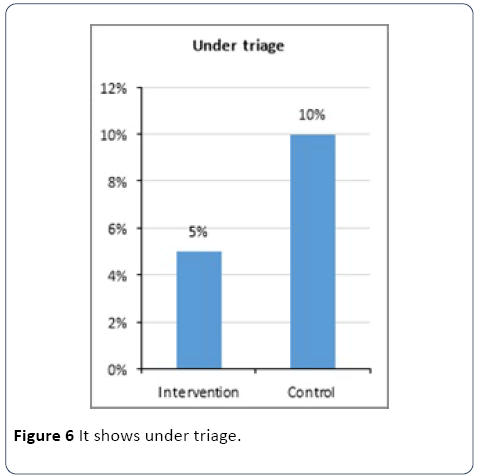
Figure 6: It shows under triage.
This clearly shows the effectiveness and usefulness of the tabletop exercise intervention. The results of the intervention group are almost similar to the universal standards of over and under triage internationally.
The reliability of triage means that the triage tool is used to assess something in a reproducible way which was high in TTX group.
The study also tried to measure two errors intra-rater and inter-rater reliability differences which can affect the assessment of the patients. The reliability was generally better in intervention group than the control group due to their repeated training as they used START triage more but we could not measure that.
A Summary of the study is presented in table form which shows the number and category of cases and their correct triage percentages, time to triage all cases and over and under triage percentages in simple table form (Table 5).
Table 5 A summary of the study and it standardized cases triage categories.
| Intervention Group |
Control Group |
| (Table top exercise) |
(Written paper bases information) |
| T1 cases |
cases 6 |
cases 6 |
| T2 cases |
cases 6 |
cases 6 |
| T3 cases |
cases 6 |
cases 6 |
| T4 cases |
cases 2 |
cases 2 |
| Correct triage |
cases 19 |
cases 14 |
| (Accuracy) |
Accuracy 90% |
Accuracy 70% |
| Over triage |
5% |
20% |
| Under triage |
5% |
10% |
| Time to triage all cases |
minutes 5.4 |
minutes 8.2 |
| Total cases |
cases 20 |
Cases20 |
Discussion
The disaster medicine is separate branch of medicine and disaster management principals are different from ordinary emergency medicine principals. Therefore, all emergency staff including doctors and nurses is not trained sufficiently in this field [8]. This fact leads to the conclusion that all ED staff is not properly aware about MCI triage process. Therefore, this triaging issue demands serious attention for improving any healthcare systems [9,10]. A special training is needed for the teams of disaster management like emergency medical services (EMS), civil defence department, emergency departments of the hospitals and national disaster preparedness and management services.
There are plenty of methods to teach and transfer knowledge and skills to participants like lectures, workshops and table top exercises, simulations. But each one has different advantages and disadvantages. This study used table top exercise (TTX) to evaluate the mass casualty incident triage process by simple triage and rapid treatment (START) system to improve the triaging skills of emergency department staff both doctors and nurses.
This study demonstrated the significance and effectiveness of tabletop exercise on the improvement of triaging skills of ED staff for MCI triage management clinically and statistically.
The above results show that interactive methods like table top exercise (TTX) and workshops are better than the traditional teaching methods like lectures or paper based written instructions reading. The former are more effective to improve knowledge and skills of the staff or providers.
This study also shows that emergency department staff lacks the awareness, knowledge and skills about MCI triage that need urgent intervention or solution.
The contribution of this study is that it shows that conducting a table top exercise in regular bases on MCI triage for ED staff during each year is valuable to improve and maintain these skills on regular bases. But still there is a need of further studies
But still there is a need of further studies and research to clarify and confirm which teaching method is better than other to improve the MCI triage process [11].
Limitations of the study
The study limitations are:
1. Small sample size.
2. One centre study.
3. Using only one tool or system of triage (START system).
Conclusion
The table top exercise (TTX) on MCI triage for one hour improved the triaging skills of the ED medical staff up to 20% to 30% in comparison to paper based written instructions technique as well as the time to triage was also near to the half.
This study also highlights the fact that the emergency department staffs both doctors and nurses are varying in their depth of knowledge and skills about MCI triage and they need education and training regularly to improve and maintain their MCI triaging skills to be prepared for unexpected mass casualty incidents in the future.
At the end we need further studies to evaluate triage related findings like accuracy, over and under triaging, validity, reliability and time to triage.
22841
References
- Debacker M (1992) Disaster medicine, In concepts and developments in emergency. Medicine, Leuven.
- Kahn CA, Schultz CH, Miller KT, Anderson CL (2009) Does START triage work? An outcomes assessment after a disaster. Ann Emerg Med 54: 424-430.
- Franc-Law JM, Ingrassia PL, Ragazzoni L, Della Corte F (2010) The effectiveness of training with an emergency department simulator on medical student performance in a simulated disaster. CJEM 12: 27-33.
- Benson M, Koenig KL, Schultz CH (1996) Disaster triage: START, then SAVE – A new method of dynamic triage for victims of a catastrophic earthquake. Prehosp Dis Med 11: 117-124.
- Risavi BL, Salen PN, Heller MB, Arcona S (2001) A two-hour intervention using START improves prehospital triage of mass casualty incidents. Prehosp Emerg Care 5: 197-199.
- Andreatta PB, Maslowski E, Petty S, Shim W, Marsh M, et al. (2010) Virtual reality triage training provides a viable solution for disaster preparedness. Acad Emerg Med 17: 870-876.
- Kilner T, Hall FJ (2005) Triage decisions of United Kingdom police firearms officers using a multiple-casualty scenario paper exercise. Prehosp Disaster Med 20: 40-46.
- Sanddal TL, Loyacono T, Sanddal ND (2004) Effect of JumpSTART training on immediate and short-term pediatric triage performance. Pediatr Emerg Care 20: 749-753.
- Hammad KS, Arbon P, Gebbie K, Hutton (2012) A Nursing in the emergency department (ED) during a disaster: a review of the current literature. Australas Emerg Nurs J 15: 235-244.
- Seyedin H, Dolatabadi ZA, Rajabifard F (2015) Emergency nurses’ requirements for disaster preparedness. Int J Trauma Emerg Med 20: e29033.
- Pelaccia T, Delplancq H, Triby E, Bartier JC, Leman C, et al. (2009) Can teaching methods based on pattern recognition skill development optimize triage in mass-casualty incidents? Emerg Med J 26: 899-902.











